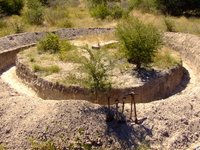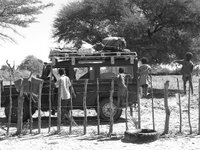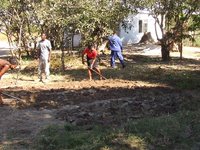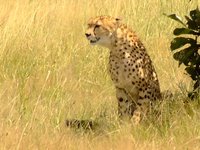Back in the US.

Sorry for the lack of updates. Ive been in the bush (no electricity) then I had to get ready and leave for home. So I haven't been able to update the blog as much as I hoped the last couple of weeks but I'll update everyone on what I was doing last before I left.
At TOCADI economic self-reliance and independence is an essential component. The Culture Hike is a specific component of this. The aim of the hike is to facilitate economic growth in neighboring Sekondomboro communities through tourism. At that TOCADI hopes to promote and educate the tourists on different people’s traditions and create pride amongst the communities for their unique cultures. This is not an unforeseen way of seeking economic development for these peoples.

Tourism in is of a growing importance in Botswana. With 17% of the country defined as protected areas and an additional 22% dedicated to wildlife management Botswana has been steadily attracting tourist to the country, helping employ around 10 thousand people. Also, in the last 20 years the San have become a popularized topic for books and movies. Therefore, promoting tourism in these communities through the Culture Hike appears to be a logical means of economic build up. For several years TOCADI has been putting on different cultural Hikes offering a glimpse at traditional practices and peoples.
Around 28 Canadian and University of Botswana students took part in the hike as part of the World University Service of Canada (WUSC). They were guided on a four day hike through different San communities along the delta and got the opportunity to see different villages and traditional performances. The different traditional dances, songs, and stories were all performed by the local peoples in each different village.

The tour took surprisingly only a week to organize and finalize. TOCADI and the Culture Hike team would communicate with each community through their designated VTC (Village Trust Committee). Then with the help of the VTC, TOCADI helped organize the different performers, guides, cooks, and manual laborers needed to complete the hike. Prices were negotiated between TOCADI with the VTC and the performers, with the payments being made after the completion of the Culture Hike.
The Culture Hike was well organized and always managed to stay on schedule. It moved through many different communities which included Kaputura, Lakao, Sekondomboro, Ngarage, and Nlôâxom. The students stayed in Kaputura, Sekondomboro, and Nlôâxom where the students viewed the different traditional performances.

An important part of the Culture hike is how it employs and includes different community members who are not performers. For example, community members were employed to help guide the tours and help the students. The students hiked around 15km a day and would stop for lunch and dinner in different communities.
In addition, the team, community members, and I woke up early every morning to help take down tents and cook food for the students. The meals and the camps were all prepared by the communities and many community members came out to greet the students. The VTC and community member who helped on the hike received money from TOCADI for there efforts and participation in the Culture Hike.
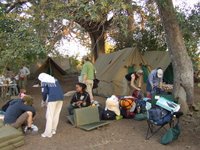
However, the tour didn’t bring in as much money as I expected, as the Canadian students only paid 3 thousand pula for the entirety of 4 day hike. Nevertheless this is more than the communities would receive through any other needs, and within the communities there are little opportunities available for employment or jobs.
The performances were usually at night around the campfire, and there was always a crowd of people from the communities singing and dancing along with the performers. The visitors which added an important element of villiage life to the performances with all ages and sexes came out to see the performances and. The atmospheres of the performances were low key with no elaborate dress or settings. The students definitely enjoyed the performances as well, and they got to see a variety of different traditional performances by different peoples (San and Hambukushu). This was important because they saw how diverse the population was out in northern Botswana. They were also allowed and able to take pictures of the performances and performers if the lighting allowed.

The picture above is of one of the San's traditional healing dances. Throughout their history the San have healed the sick through dance and song. The sick person would lay down and the doctor would do whatever he needed to heal the person while performing a dance or song. Then the person would rise and be healed. Below is a picture of a traditional hunting song. Before going on a hunt you the hunter makes a fire and then throws some dirt, clay, or herbs into the fire. Following this the hunter sings a song with his bow and arrow TO the animal he wants to kill, asking it to come to him. The San are somewhat famous for their arrows, which have a poisin that paralyzes and kills the animal no matter how big or small. In the north they make their poison from crushed worms they get from rotting fruit in the bush. Other San peoples use scorpions or other poisonous animals to make their arrows.

Personally I was skeptical of the idea of cultural tourism. There are inherently some ethical dilemmas surrounding the voyeuristic nature of tourism. The idea of large groups of people coming in with cameras, vans, and tents seems not only invasive but deprecating towards the people and their way of life. On the other hand, after completing the hike I have since warmed up a little to the idea of the Culture Hike. A sense of pride created in the locals because the students showed such interest in what they were doing which was not expected. Many of the students were more than willing to try and learn the local languages and customs which was something I personally saw as important to their learning experience. Most importantly the hike is putting money into very small and impoverished communities with no other means of economic growth. Also, the students were very respectable and carried themselves very well for only being in Botswana for several weeks.
The excitement and interest for the communities amongst the students; specifically the arts and crafts at the TOCADI office was an important result of the hike. After the hike, students jumped at the chance to own a part of what they partook in. TOCADI sold the vast majority of their baskets, and earned around 2.5 thousand pula in just basket sales. This almost doubled the amount of money received by TOCADI for the Culture Hike. Sadly, the office was out of cd’s and many of the students were disappointed they were not able to buy any of the music they heard in the villages.
This will not be the last Culture Hike put on by TOCADI. There is already a new hike scheduled for January of next year. The TOCADI culture Hike is still something new the organization is doing and it’s still learning how to organize it appropriate.
So I guess that about covers my last couple of weeks in Botswana. Its good to be home now though. I want to say thank you to everyone for reading and putting up with my bad spelling and grammer.
Travis








